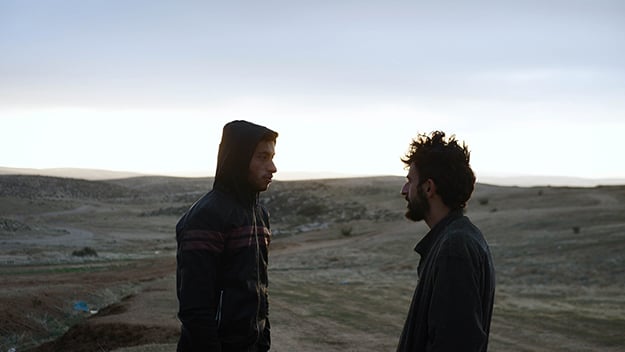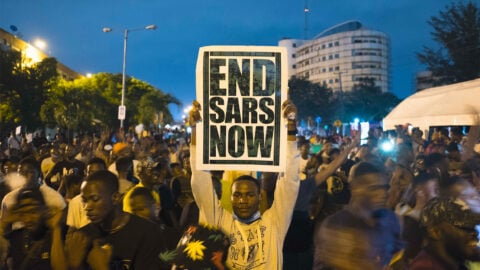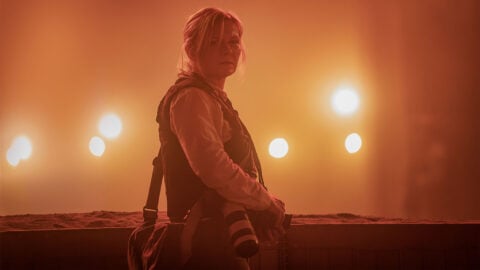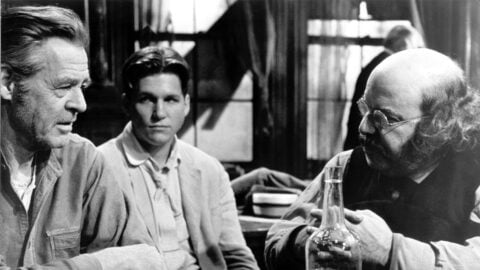Interview: Yuval Abraham & Basel Adra on No Other Land
This article appeared in the March 29, 2024 edition of The Film Comment Letter, our free weekly newsletter featuring original film criticism and writing. Sign up for the Letter here.

Basel Adra and Yuval Abraham in No Other Land (Basel Adra, Yuval Abraham, Rachel Szor, Hamdan Ballal; 2024)
Since its premiere in February at the Berlinale, the documentary No Other Land has been the talk of the festival circuit, a subject of both fiery discourse and critical acclaim. Co-directed by a collective of Palestinian and Israeli artists, including the journalists Basel Adra and Yuval Abraham, the film is composed of footage shot between 2019 and 2023, showing the violent expulsion of the people of Masafer Yatta in the West Bank by the Israeli Defense Forces (IDF).
The images are direct, incontrovertible, and brutal; it’s gutting to watch bulldozers and armed Israeli soldiers uproot the paltry homes and lives of Palestinians, and to recognize the similarity of these scenes to those flooding social media at the present moment. Yet if the last months have shown us anything, it’s that images of violence in themselves effect much less in terms of change than we might hope. As far back as 1980, John Berger argued that pictures of war crimes in Vietnam shocked the viewer not just with their content but also by exposing “his own personal moral inadequacy,” for which the penance is likewise individual and moral: at best, a humanitarian contribution.
But No Other Land seeks to induce neither pity nor shock. It is, as Adra says in voiceover toward the end of the film, “a story about power.” It is a portrait of war as a structure, not an event—a beautiful, often poetic portrait of the friendship between two young men of the same age who live 30 minutes from each other, but are entirely different political subjects in what they repeatedly describe as an apartheid state. And faced with the barrels of Israeli rifles, as they throw their bodies in front of tanks, they’re both powerless. The effect of the film is not to make us feel inadequate in the face of incommensurable horror, but to remind us that violence is the taking of power—and justice can come only from its reclamation.
At their premiere screening, which was met with a standing ovation, Adra and Abraham took to the stage to reiterate these truths: Adra criticized the Berlinale for not calling for a cease-fire and the German state for continuing to arm Israel in Gaza, and Abraham emphasized that the two of them sharing the stage as co-directors did not mean they were equal in the eyes of the world. It was a speech they would echo at the awards ceremony on February 24, where they won the Best Documentary Film Prize—a speech whose message was tragicomically reinforced when Claudia Roth, the German minister of state for culture, issued a statement clarifying that her applause was directed only at Abraham.
The film continues its journey, however—last week, it won the Audience Award at this year’s Copenhagen International Documentary Film Festival. Back at the Berlinale, I chatted with Adra and Abraham in the lobby of their hotel about the making of the movie, and the hope and the hubris that necessarily drives art-making in the face of brutality.
You are both journalists. At what point did you feel that you needed to use cinema as a form to tell this story?
BA: First, we wanted to reach a wider audience. The other thing is that we wanted to tell the story of Masafer Yatta, our community, and the expulsion that happened there as a story. Our expulsion didn’t happen in one day, but through different laws, building settlements, using violence against us, and bulldozing our homes and schools. They come year after year making our lives miserable, so this is what we wanted to build as a story, as a documentary.
YA: When you’re making a film, you’re able to draw a line that connects many events together, and when you look at it from afar, you can see a clear policy that you sometimes miss if you’re just focused on particular journalistic events. A second important reason is that when you’re making a film, you’re able to touch the factual truth but also an emotional truth. For example, Basel spoke about the foreign law that controls us. That creates a sense of helplessness: you are standing in front of a bulldozer and the soldiers occupying you; you didn’t choose them. You can write about a sense of helplessness, but when you see it emotionally—and you can only do that in a documentary, I think—it hits a different place.
Last November, I attended a series of screenings organized by Bidayyat, a Beirut-based production hub that emerged during the Syrian Revolution. I asked one of the founders, Mohammad Ali Atassi, who used to be a journalist, the same question—why use cinema to tell stories during the war? One of the things he said was that as a journalist, there’s the pressure to seem objective, or else you’re not taken seriously. But with cinema you can be subjective—you can be in the midst of what’s happening and tell that story, and people will take it as legitimate.
YA: Sometimes we imagine objectivity and subjectivity as something very binary, but there’s a lot of truth in the world, and you can grasp that truth from very different angles. It was very important to us that the documentary is truthful. Sometimes people understand objectivity as presenting a both-sides story. But if you look at Masafer Yatta, it’s not a both-sides story.
As Ghassan Kanafani said, it’s a “conversation between the sword—”
YA: “—and the neck.” Exactly. If you don’t make it between the sword and the neck, then it’s more objective because it portrays the power imbalance that exists in reality.
The film has all this footage of violence, which I found hard to watch knowing that it was from three years ago, and the same things are happening now—that fatigue of repetition. But there are also these beautiful moments of you both hanging out or driving or talking. Can you talk about how you arrived at the structure of the film and the balance between those two modes?
BA: The violence and the demolitions, the expulsion of Masafer Yatta, have been going on since the 1980s when they first declared it a firing-zone area. But on the other hand, life continues. People are getting married and having children. The army demolishes, and we rebuild. So we have to tell the audience that we’re human beings, that we have our own lives. These structures the army destroys, they mean a lot to us—the schools, the houses. There’s a life here, and the life could be very nice if the occupation didn’t exist.
YA: It took us a while to figure out how to balance the scenes of life, and the conversations between me and Basel, with the violence, so the viewer can manage to watch the film. You want them to see the violence because it’s important, especially for Westerners who have a responsibility for that violence and are supporting it, but we didn’t want to lose people completely. The short answer is that it was a lot of trial and error. We worked with Anne Fabini, a Romanian film editor who lives in Berlin. Her help was great in finding this balance. We were also in this program called the Close Up Initiative for films made in the Middle East. It’s an organization based in Belgium, led by Sigal Yehuda, and it’s this network of advisors that take films from the Middle East, often by first-time filmmakers like us, and connect us to funders and give a lot of feedback. We were also in the Sundance Lab more recently.
Can you talk about the process of finding funding? You said it was hard at first.
YA: We made a decision that we didn’t want to take money from Israel. We wanted to keep the film completely independent, so that limited the ways we could get money. Palestinian cinema doesn’t have a lot of resources.
BA: We didn’t want money from the government that is ethnically cleansing us and expelling us from our land.
YA: That’s the main reason. The other reason is the history of the Israeli state funding films and then conditioning that support by limiting the ways in which the film can be critical of the government. Recently there was a film called H2: The Occupation Lab that had that problem.
It was difficult at first, because we didn’t have connections. We did a lot of the work on the film for the first two years almost as volunteers.
On spec, as they say.
YA: Exactly. Then through Close Up, we were connected with Sundance and IDFA [International Documentary Film Festival Amsterdam], and we found Norwegian producers, Antipode Films, and we managed to raise some money. But it’s not sustainable. What we did is not a model I would copy for other films, because a lot of it was working for free [laughs].
My favorite exchange in the film is when you, Yuval, complain that your article about Masafer Yatta doesn’t have many views, and Basel, you gently chide him, saying: “You’re enthusiastic, you want to solve everything in 10 days and you want to go back, but this has been going on for decades.” I found that very moving. It’s a form of hubris that writers and artists often have, believing that their work can effect change. How did you grapple with that, and with the feeling of futility that you often underline in the movie?
BA: We don’t have many tools to fight with. And we know there is propaganda thrown around—there is a system fighting to hide the truth, and we’re addressing that in the film, how difficult it is to film the reality. I know that as long as this community exists, we need to keep speaking out, filming, writing, and using social media. Everything is part of our activism, even the movie. It’s a struggle against propaganda. It is not just about an attack here and there; you have to write about everything, the attacks, the life, and you have to film the reality. You have to build this process, in a way, and keep it going.
YA: You’re right because I’m always shocked at film festivals, where everybody has this narrative that art is going to change the world, and it’s extremely cringe. This is what meeting Basel changed in me. When you come from a privileged place and life is easy for you, you underestimate it. But actually, you have to be super patient and know that you are doing things that will maybe have no impact. Why we put that in the film is because of what Basel says in it, that it’s very much about power. One power structure we look at is between the military and the population at Masafer Yatta, but we also want to look critically at the power imbalance between the writers, the people who document the violence, and the victims of violence.
Like the scene with Harun [who was shot by the IDF and became paraplegic] at the end, when Western journalists come to interview him and his mother.
YA: Harun’s mother says: All these journalists came here and what did we get? Harun is still living in the cave. Documentaries sometimes try to hide these elements to make it a clean picture, but we thought it was right to show it, because it is part of it, and it is problematic and it relates to power.
BA: A lot of people today are disappointed more than ever because things are getting worse and worse. We come to film their home being demolished, they rebuild it, then the bulldozers come back to demolish it—we come back four or five times during this process, and they look at us like, why are you even doing this? It’s like that soldier tells Yuval—just change the dates, it’s the same thing happening again and again. I’m not sure this will do anything, but for me it’s the only hope, that one day it could change something. If I don’t do it, I ask myself what else I can do—stay silent and let it go?
Another difference between journalism and the movies is that journalism is responsive. Something happens, and in the next few days you report on it. Cinema takes time. What is it like working with footage of things that happened in 2020 and 2021, and showing it in 2024? The postscript reveals Harun passed away after the filming was done. There’s something about cinema where you’re sitting with footage of ghosts, in a way.
YA: It’s ongoing. You have a school that was demolished in the past, but you know that while you’re editing that footage, another five schools are being destroyed. It’s a strange feeling because you’re editing the past, but the past is so similar to the present, and you know it’s going to be like that in the future. There’s also a challenge from a storytelling perspective: how do you portray that? It’s good to have repetition, but any kind of story needs movement, and this is something you don’t always recognize as a journalist, because you’re so stuck in the day-to-day events. But then while making the documentary, you take a step back and you’re able to see how things are moving: they took down the water and the roads and the school and the hospital. You see how they’re slowly destroying the entire space.
What kind of filmmaking tools did you have? Different scenes in the movie have different resolutions and textures.
YA: Rachel [Szor], our cinematographer, used a Lumix GH5 camera, a 4K camera. And then there are the cameras Basel and I filmed with.
BA: 4K cameras that you can hold in the hand, that made it easier to run with. But the archival footage was taken by different cameras—phones, neighbors’ DVDs, or cassettes. Some of the footage is from 2005. So it’s a combination of these elements.
YA: There’s one scene where a woman is getting shot, and that was filmed with someone’s phone when Basel’s camera stopped working.
BA: For the demolition scenes, we came with our cameras, because we knew in advance they were coming. But sometimes there’s the violence by the settlers that would happen quickly, so we would pick up our phones. The shooting of my cousin, for example: I heard screaming, and I went to the camera and started filming. It’s not a film where we could say: now I’m ready to start, you stop, go bring the lights, and all that.
I have to say, the film looks very beautiful, so kudos to your team.
YA: It was important for us to have this quality. So much footage is going around about this violence, and people become numb to it. We are looking for a way to make people see again. You can do that in many different ways, and sometimes having a very good technical presentation can be a political tool, to help people see something they wouldn’t otherwise see.
In the film, you talk a lot about the differences in your situation: Yuval, you can go visit Basel in the West Bank, but Basel, you can’t visit Yuval. Have these asymmetries come up in the festival circuit?
BA: I mean, getting here was different for sure. Yuval can fly from an airport at Tel Aviv and arrive here. For me, I have to drive all the way in a taxi from the south to the border of Jericho. Today a lot of the roads are blocked by settler soldiers in the West Bank, so you have to find ways to get to Jericho, and then be checked at the border before entering Jordan. And you have to go hours or sometimes a day in advance before the plane to enter Jordan and travel from the center to the airport. It took me 30 hours.
YA: For me, it’s like four hours.
Yuval, you say in the film that learning Arabic changed your political views. Is there a particular moment or experience that made you see differently?
YA: Learning Arabic was important because it allowed me to meet people. I met people like Basel, and then you don’t just know that there’s an occupation, but you feel it in your heart. You care about certain people and you see how brutal the system is to them, how unjust. It’s not just knowing the language and understanding something on a rational level, but you get to understand something deeper, on an emotional level. When I first met Basel in Masafer Yatta five years ago, on that same day soldiers raided Basel’s village. They brought so many forces and destroyed the sheep shelter. That was the first time I heard stun grenades. Basel probably heard them from… I don’t know what age. It was shocking to see this amount of violence used against families. And for what? For destroying a sheep shelter? That experience made me feel responsible. It made me want to come back.







